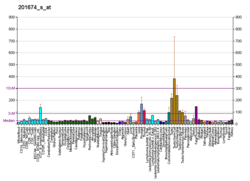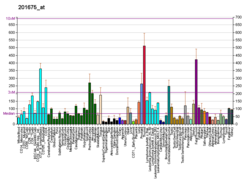
Summary
A kinase anchor protein 1, mitochondrial is an enzyme that in humans is encoded by the AKAP1 gene.[5][6][7]
| AKAP1 | |||||||||||||||||||||||||||||||||||||||||||||||||||
|---|---|---|---|---|---|---|---|---|---|---|---|---|---|---|---|---|---|---|---|---|---|---|---|---|---|---|---|---|---|---|---|---|---|---|---|---|---|---|---|---|---|---|---|---|---|---|---|---|---|---|---|
| Identifiers | |||||||||||||||||||||||||||||||||||||||||||||||||||
| Aliases | AKAP1, AKAP, AKAP121, AKAP149, AKAP84, D-PPP1R43, PRKA1, SAKAP84, TDRD17, A-kinase anchoring protein 1 | ||||||||||||||||||||||||||||||||||||||||||||||||||
| External IDs | OMIM: 602449 MGI: 104729 HomoloGene: 31165 GeneCards: AKAP1 | ||||||||||||||||||||||||||||||||||||||||||||||||||
| |||||||||||||||||||||||||||||||||||||||||||||||||||
| |||||||||||||||||||||||||||||||||||||||||||||||||||
| |||||||||||||||||||||||||||||||||||||||||||||||||||
| |||||||||||||||||||||||||||||||||||||||||||||||||||
| |||||||||||||||||||||||||||||||||||||||||||||||||||
| Wikidata | |||||||||||||||||||||||||||||||||||||||||||||||||||
| |||||||||||||||||||||||||||||||||||||||||||||||||||
Function edit
The A-kinase anchor proteins (AKAPs) are a group of structurally diverse proteins that have the common function of binding to the regulatory subunit of protein kinase A (PKA) and confining the holoenzyme to discrete locations within the cell. This gene encodes a member of the AKAP family. The encoded protein binds to type I and type II regulatory subunits of PKA and anchors them to the mitochondrion. This protein is speculated to be involved in the cAMP-dependent signal transduction pathway and in directing RNA to a specific cellular compartment.[7]
Interactions edit
AKAP1 has been shown to interact with:
References edit
- ^ a b c GRCh38: Ensembl release 89: ENSG00000121057 – Ensembl, May 2017
- ^ a b c GRCm38: Ensembl release 89: ENSMUSG00000018428 – Ensembl, May 2017
- ^ "Human PubMed Reference:". National Center for Biotechnology Information, U.S. National Library of Medicine.
- ^ "Mouse PubMed Reference:". National Center for Biotechnology Information, U.S. National Library of Medicine.
- ^ Trendelenburg G, Hummel M, Riecken EO, Hanski C (Sep 1996). "Molecular characterization of AKAP149, a novel A kinase anchor protein with a KH domain". Biochem Biophys Res Commun. 225 (1): 313–9. doi:10.1006/bbrc.1996.1172. PMID 8769136.
- ^ Lin RY, Moss SB, Rubin CS (Jan 1996). "Characterization of S-AKAP84, a novel developmentally regulated A kinase anchor protein of male germ cells". J Biol Chem. 270 (46): 27804–11. doi:10.1074/jbc.270.46.27804. PMID 7499250.
- ^ a b "Entrez Gene: AKAP1 A kinase (PRKA) anchor protein 1".
- ^ a b Yukitake H, Furusawa M, Taira T, Iguchi-Ariga SM, Ariga H (Nov 2002). "AAT-1, a novel testis-specific AMY-1-binding protein, forms a quaternary complex with AMY-1, A-kinase anchor protein 84, and a regulatory subunit of cAMP-dependent protein kinase and is phosphorylated by its kinase". J. Biol. Chem. 277 (47): 45480–92. doi:10.1074/jbc.M206201200. PMID 12223483.
- ^ Furusawa M, Ohnishi T, Taira T, Iguchi-Ariga SM, Ariga H (Sep 2001). "AMY-1, a c-Myc-binding protein, is localized in the mitochondria of sperm by association with S-AKAP84, an anchor protein of cAMP-dependent protein kinase". J. Biol. Chem. 276 (39): 36647–51. doi:10.1074/jbc.M103885200. PMID 11483602.
- ^ a b Carlson CR, Ruppelt A, Taskén K (Mar 2003). "A kinase anchoring protein (AKAP) interaction and dimerization of the RIalpha and RIbeta regulatory subunits of protein kinase a in vivo by the yeast two hybrid system". J. Mol. Biol. 327 (3): 609–18. doi:10.1016/S0022-2836(03)00093-7. PMID 12634056.
- ^ a b Herberg FW, Maleszka A, Eide T, Vossebein L, Tasken K (April 2000). "Analysis of A-kinase anchoring protein (AKAP) interaction with protein kinase A (PKA) regulatory subunits: PKA isoform specificity in AKAP binding". J. Mol. Biol. 298 (2): 329–39. doi:10.1006/jmbi.2000.3662. PMID 10764601.
- ^ Kapiloff MS, Schillace RV, Westphal AM, Scott JD (Aug 1999). "mAKAP: an A-kinase anchoring protein targeted to the nuclear membrane of differentiated myocytes". J. Cell Sci. 112 (16): 2725–36. doi:10.1242/jcs.112.16.2725. PMID 10413680.
External links edit
- Human AKAP1 genome location and AKAP1 gene details page in the UCSC Genome Browser.
Further reading edit
- Lester LB, Scott JD (1997). "Anchoring and scaffold proteins for kinases and phosphatases". Recent Prog. Horm. Res. 52: 409–29, discussion 429–30. PMID 9238861.
- Michel JJ, Scott JD (2002). "AKAP mediated signal transduction". Annu. Rev. Pharmacol. Toxicol. 42: 235–57. doi:10.1146/annurev.pharmtox.42.083101.135801. PMID 11807172.
- Huang LJ, Durick K, Weiner JA, et al. (1997). "Identification of a novel protein kinase A anchoring protein that binds both type I and type II regulatory subunits". J. Biol. Chem. 272 (12): 8057–64. doi:10.1074/jbc.272.12.8057. PMID 9065479.
- Huang LJ, Wang L, Ma Y, et al. (1999). "NH2-Terminal Targeting Motifs Direct Dual Specificity A-Kinase–anchoring Protein 1 (D-AKAP1) to Either Mitochondria or Endoplasmic Reticulum". J. Cell Biol. 145 (5): 951–9. doi:10.1083/jcb.145.5.951. PMC 2133123. PMID 10352013.
- Herberg FW, Maleszka A, Eide T, et al. (2000). "Analysis of A-kinase anchoring protein (AKAP) interaction with protein kinase A (PKA) regulatory subunits: PKA isoform specificity in AKAP binding". J. Mol. Biol. 298 (2): 329–39. doi:10.1006/jmbi.2000.3662. PMID 10764601.
- Steen RL, Martins SB, Taskén K, Collas P (2000). "Recruitment of Protein Phosphatase 1 to the Nuclear Envelope by a-Kinase Anchoring Protein Akap149 Is a Prerequisite for Nuclear Lamina Assembly". J. Cell Biol. 150 (6): 1251–62. doi:10.1083/jcb.150.6.1251. PMC 2150688. PMID 10995432.
- Furusawa M, Ohnishi T, Taira T, et al. (2001). "AMY-1, a c-Myc-binding protein, is localized in the mitochondria of sperm by association with S-AKAP84, an anchor protein of cAMP-dependent protein kinase". J. Biol. Chem. 276 (39): 36647–51. doi:10.1074/jbc.M103885200. PMID 11483602.
- Razani B, Lisanti MP (2001). "Two distinct caveolin-1 domains mediate the functional interaction of caveolin-1 with protein kinase A". Am. J. Physiol., Cell Physiol. 281 (4): C1241–50. doi:10.1152/ajpcell.2001.281.4.C1241. PMID 11546661. S2CID 34190425.
- Yukitake H, Furusawa M, Taira T, et al. (2003). "AAT-1, a novel testis-specific AMY-1-binding protein, forms a quaternary complex with AMY-1, A-kinase anchor protein 84, and a regulatory subunit of cAMP-dependent protein kinase and is phosphorylated by its kinase". J. Biol. Chem. 277 (47): 45480–92. doi:10.1074/jbc.M206201200. PMID 12223483.
- Furusawa M, Taira T, Iguchi-Ariga SM, Ariga H (2003). "AMY-1 interacts with S-AKAP84 and AKAP95 in the cytoplasm and the nucleus, respectively, and inhibits cAMP-dependent protein kinase activity by preventing binding of its catalytic subunit to A-kinase-anchoring protein (AKAP) complex". J. Biol. Chem. 277 (52): 50885–92. doi:10.1074/jbc.M206387200. PMID 12414807.
- Strausberg RL, Feingold EA, Grouse LH, et al. (2003). "Generation and initial analysis of more than 15,000 full-length human and mouse cDNA sequences". Proc. Natl. Acad. Sci. U.S.A. 99 (26): 16899–903. Bibcode:2002PNAS...9916899M. doi:10.1073/pnas.242603899. PMC 139241. PMID 12477932.
- Carlson CR, Ruppelt A, Taskén K (2003). "A kinase anchoring protein (AKAP) interaction and dimerization of the RIalpha and RIbeta regulatory subunits of protein kinase a in vivo by the yeast two hybrid system". J. Mol. Biol. 327 (3): 609–18. doi:10.1016/S0022-2836(03)00093-7. PMID 12634056.
- Steen RL, Beullens M, Landsverk HB, et al. (2004). "AKAP149 is a novel PP1 specifier required to maintain nuclear envelope integrity in G1 phase". J. Cell Sci. 116 (Pt 11): 2237–46. doi:10.1242/jcs.00432. PMID 12697839.
- Hillman RT, Green RE, Brenner SE (2005). "An unappreciated role for RNA surveillance". Genome Biol. 5 (2): R8. doi:10.1186/gb-2004-5-2-r8. PMC 395752. PMID 14759258.
- Cardone L, Carlucci A, Affaitati A, et al. (2004). "Mitochondrial AKAP121 Binds and Targets Protein Tyrosine Phosphatase D1, a Novel Positive Regulator of src Signaling". Mol. Cell. Biol. 24 (11): 4613–26. doi:10.1128/MCB.24.11.4613-4626.2004. PMC 416429. PMID 15143158.
- Beausoleil SA, Jedrychowski M, Schwartz D, et al. (2004). "Large-scale characterization of HeLa cell nuclear phosphoproteins". Proc. Natl. Acad. Sci. U.S.A. 101 (33): 12130–5. Bibcode:2004PNAS..10112130B. doi:10.1073/pnas.0404720101. PMC 514446. PMID 15302935.









